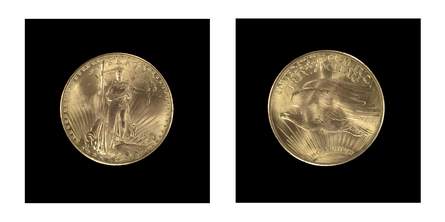
PREV ARTICLE
NEXT ARTICLE
FULL ISSUE
PREV FULL ISSUE
LATEST IN THE 1933 $20 GOLD CASE
This Associated Press story brings the latest news in the legal battle over the Langbord family 1933 Double Eagle hoard. -Editor

A federal appeals court is again weighing the fate of 10 rare gold coins possibly worth $80 million or more that the government says were illegally taken from a Philadelphia mint and wound up in a jeweler's hands. A lawyer for jeweler Israel Switt's heirs told the 3rd U.S. Circuit Court of Appeals on Wednesday that authorities gave up any right to the coins when they failed to respond to the family's seized-property claim within 90 days. The Treasury Department insists the $20 Double Eagles were stolen from the U.S. Mint in Philadelphia before the 1933 series was melted down when the country went off the gold standard. They argued the heirs, Joan Langbord and her sons, cannot lawfully own the coins, which she said she found in a family bank deposit box in 2003. The government regained possession of the coins when the family brought them to the Secret Service to be authenticated. So far in the decade-long battle, both sides have been declared winners. In 2009, a judge ruled that the government improperly seized the coins and denied the family due process when officials at the U.S. Mint in Philadelphia decided to keep them after the family asked that they be authenticated. Two years later, a jury found the seizure had been legal because the coins hadn't been circulated and must therefore have been stolen. A three-judge appellate court flipped the result again in April, ruling 2-1 in favor of Switt's family. One Double Eagle, once owned by King Farouk of Egypt, sold in 2002 for $7.6 million, then a record for a coin. Its later owner, a London coin dealer once jailed by the U.S. over it, split the proceeds with the U.S. Langbord lawyer Barry Berke brokered that deal. The Langbords offered the government a similar split but were rebuffed.
And what makes people think the coins are really worth $80M? They're multiplying the sale price of one coin by ten. But by the laws
of supply and demand, increasing the supply tenfold would push the price of each down, at least somewhat. Were there really ten
underbidders wanting to buy one at nearly $8M? -Editor
To read the complete article, see:
Wayne Homren, Editor The Numismatic Bibliomania Society is a non-profit organization promoting numismatic literature. See our web site at coinbooks.org. To submit items for publication in The E-Sylum, write to the Editor at this address: whomren@gmail.com To subscribe go to: https://my.binhost.com/lists/listinfo/esylum All Rights Reserved. NBS Home Page Contact the NBS webmaster 
|